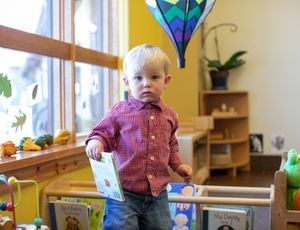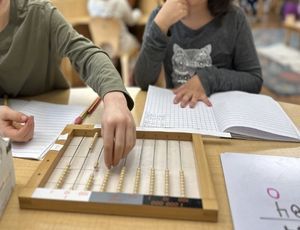Children use sleep for both their physical and mental development. Dr. Montessori emphasizes that self-care skills are fundamental for children to master caring for themselves, the environment, and others. In this month´s article, we will look into how to better assist children in their growth toward independence in sleeping.
A prepared environment not only sets the stage for sleep, but also answers the child´s need for order. The child uses a floor bed that can be just the mattress on the floor, or it can be a low wooden frame with a mattress. This bed should always be in the same place. Just as the child has a predictable place to rest, the adult should have a predictable place in the room to sit while the child learns how to sleep independently. If the child wakes up during the night or a daytime nap, the adult comes and slowly calms him and explains that it is time to rest and that they will see each other later; this needs to be done as many times as the child wakes up during the first days until he internalizes the process and expectations of sleeping independently. Remember that each time the adult calms, the child should be calmed as if it was the first time, with patience, respect, and love. If our attitude toward the child becomes irritable or judgmental, the child has no option but to explore the attitude, which will create more repetition.
Changes in the atmosphere, such as closing the blinds and dimming the lights, are ways the prepared environment communicates to the child that is time to rest. The routine that leads to sleep, and follows sleep, must be consistent so your child may internally prepare for what is coming next. Parents or the primary caregiver establishes this routine. When setting up a sleeping routine, it helps if the adult calmly describes what is occurring, step by step, but without high energy. We want to communicate that the pace is slowing, and sleeping is coming. With a very young infant, it is great to gently put him on his back, giving him the language of what is happening. “It is time to rest, enjoy. I will see you when you wake up.” If the baby moves or rolls, we let him get into a position that he is more comfortable with.
You might ask why you can’t sit with your child and rub or pat his back to help him relax and sleep. It’s a good question. Children have a strong desire for independence. Sleeping is one of those areas that human beings need to do and are capable of doing independently. When we offer to sit next to the child or pat his back, we teach him that he cannot sleep without having that attachment. That is why we return to the child with a soothing, calm attitude. Leaving him to “cry it out” won’t help either. Children need to trust that their needs will be met and that someone is here to assist them in developing independence.
Lastly, we encourage you to talk to the child if he falls asleep somewhere else, and later on, you carry him. When your child gets slightly awake because of the movement, inform him you are moving him into his room. Imagine if you fell asleep on the couch with your jeans and shirt on, and after a couple of hours, you woke up in a different, dark room wearing your pajamas; the odds are that you will be extremely disoriented and anxious. Feelings toward the sleeping experience would arise. Children feel the same way; they also like to know what happens to their bodies.
Quote of the Month
“Remember, nobody can make another person fall asleep. How to relax and let sleep come is a skill your child, like everybody else must learn all by herself.”
-Magda Gerber
Book of the Month
Your Self-Confident Baby: How to Encourage Your Child's Natural Abilities from the Very Start by Magda Gerber and Allison Johnson
This is a wonderful book written by the founder of Resources for Infant Educarers (RIE), Magda Gerber. She talks in detail about daily routines with infants and toddlers, such as bathing, diapering, sleeping and eating. She also covers the importance of observation at home and has practical advice to better support children through these transitions. It is a book that is easy to read and hard to put down.
Link to buy it on Amazon:
https://www.amazon.com/s?k=Your+Self-Confident+Baby%3A+How+to+Encourage+Your+Child%27s+Natural+Abilities+from+the+Very+Start+by+Magda+Gerber+and+Allison+Johnson&ref=nb_sb_noss



